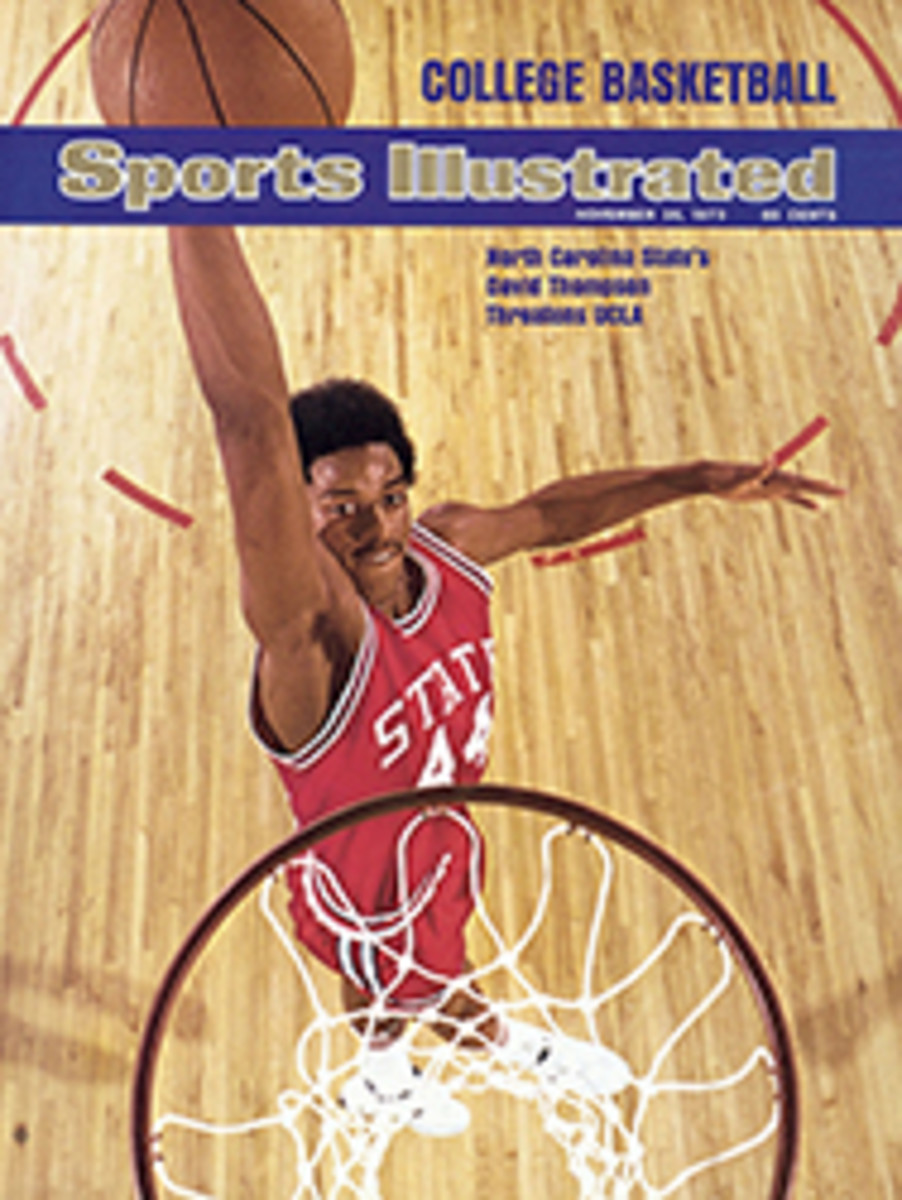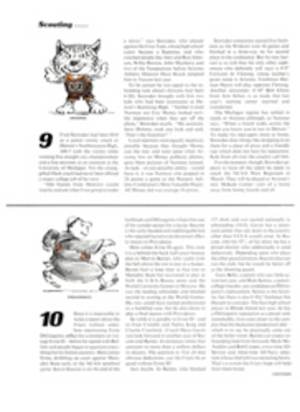
ARTIS AND THE QUICK-CHANGE ARTISTS
Kentucky Forwards Dan Issel and Wendell Ladner were already sprinting across midcourt when Center Artis Gilmore made a second leap at a rebound which had remained tantalizingly at basket level, skipping off his fingertips to those of Pacers Mel Daniels and George McGinnis and then back again. The ball finally in his grasp, Gilmore turned, took one huge step toward the foul line and threw a pass two-thirds the length of Louisville's Freedom Hall to Ladner running a fly pattern down the left sideline. Without taking a dribble, Ladner bounced a cross-court pass to Issel, who was cutting in from the opposite side. Issel took the ball in full stride, glided past a solitary Indiana defender and scored an easy lay-in, giving the Colonels an early six-point lead in their 100-96 win over the defending ABA champions last week.
The play was nothing more than an old-fashioned fast break—old-fashioned, that is, to many teams other than the Colonels, for whom the break is decidedly newfangled. In the two seasons that the 7'2" Gilmore and the 6'9" Issel had previously played together, Kentucky had become the Lawrence Welk of pro basketball—a-one and a-two and a-Artis and a-Dan. Rather than trying to run away from the opposition, the Colonels preferred to walk the ball upcourt and pass it inside in an attempt to collapse the inner defenses. Since Gilmore and Issel weigh 240 pounds apiece and are immensely strong, this approach had its effective moments, particularly two seasons ago when Kentucky won 68 games. But the Colonels' failure to get past the first playoff round in 1972 and a decline in their fortunes last season revealed their power offense to be too static and predictable. And, said the Kentucky ownership, too boring to watch. A change to the running game was ordered up, with unpredictable results for a team with barely average speed. Now it is the other clubs that are catching static from Kentucky, which at week's end led the ABA's Eastern Division with a 13-3 record, the best in the league.
Altering its offense from a walk to a run has not been the only quick change Kentucky has undergone of late. Near the end of last season, the youthful Louisville millionaires who owned the team sold it up the river—to Cincinnati. The franchise remained there only three months before being repurchased by one of the former owners, John Y. Brown Jr., who made more than $300 million selling Kentucky Fried Chicken. Actually, the official owner of the team is Brown's 33-year-old wife Ellie, a former cheerleader at Central City (Ky.) High. Ellie balks at suggestions that her name only appears on the ownership papers because it might provide a tax shelter or free her husband to seek the Senate seat he is known to covet. Asked what she knew about basketball, she replied, "My husband didn't know anything about frying chicken," and immediately named an all-woman board of directors (later integrated by a non-girl named Adolph Rupp).
"I admit they've done a great job meeting businessmen and selling tickets," says one reporter, acknowledging that attendance is up more than 14%, "but the Women's Liberation folks shouldn't get too excited. This is still a puppet operation, with John Y. calling all the important shots. It's like taking a secretary and making her think she's running things by changing her title to executive assistant."
One decision John Y. definitely had a hand in was the switch to a fast-break offense. As soon as the Browns acquired the Colonels he said he thought Kentucky fans would find them more fun to watch if they ran around the court like the Rupp-coached teams he remembered down at his alma mammy, the U. of Kentucky. Statements like that sent Colonel Coach Joe Mullaney, now with Utah, and General Manager Mike Storen, now the ABA commissioner, scurrying.
Former Colonel Coach Gene Rhodes, whom Storen had fired three years ago, was hired to replace his old nemesis in the front office, and the man picked to succeed Mullaney was an even more unlikely choice. He is Babe McCarthy, Old Magnolia Breath himself, whose pro teams have never shown the slightest inclination to move any faster than their coach talks.
McCarthy claims that his slowdown style was dictated by the talent available. "I swahr on my mother's grave this ain't a change in philosophy for me," he says. "Gawdang, coachin' a fast-break team is the easiest jawb 'cause ya don't hafta figure awt how to break down defenses. I jus' never had the main ingredient ya need ta break—the big reboundin' center. When we git the runnin' game down goood—that could take 'til next yeahr—and Awrtis gits as break-conscious as I'm hopin' he will, well then we kin leave most of the reboundin' to 'im and e'ryone else kin run like heck down the cawt."
One Colonel already off and running is Issel, who has neither the speed nor the appearance associated with the sort of excellent open-court player he is. He has the kind of build usually reserved for tight ends; his quadriceps are so massive they make his kneecaps look like indentations. And he has the smile of a defenseman who has caught too many pucks with his teeth. The absence of three incisors makes Issel look like the meanest man on any court until he tells how he lost them. "I tripped over the half-court line and fell on my face in grade school," he says. "In all fairness to myself, I think it's important to mention that they had just waxed the floor."
Issel is indeed a tough customer in close to the basket, scoring on the type of set plays that were 70% of Kentucky's offense last season, but perhaps no more than 30% this year. Still, the change in offense has not reduced his average but simply made it easier for him to score his 28.4 points a game, highest in the ABA. He has done it mainly by working harder than any man his size to move out on the break.
Issel's knack of sneaking away for easy baskets is an important element in the Kentucky break because the Colonels have still to master the three-on-two attack, which is the basis of most running offenses. In a loss to Carolina earlier in the week, Kentucky turned rebounds and steals into 25 break opportunities and yet scored only 23 points. Missed shots, many of them taken too far from the goal, ill-timed passes, the failure to fill lanes in the classic fashion and Gilmore's unpolished outlet passing were to blame.
"What would give me the biggest thrill right now would be if I could learn to grab the rebound, turn in midair and throw the ball out to an open man at halfcourt before I hit the floor," says Gil-more, a quiet, perhaps too gentle man whose slender frame is deceiving; though his waist is only 32", each of his thighs is 27" around. Gilmore's hamstrings are so well developed that he appears to be running and jumping on the world's two largest frogs' legs, a real asset in his newest hobby, scuba diving.
Although he was good enough in his rookie season to be the ABA's Most Valuable Player for 1972, Gilmore is now one of the league's most improved performers. His hesitancy to block shots, which came as a result of repeated goal-tending calls in his first season, is now gone and he so thoroughly dominates the league in rebounding that his average of 18.8 a game leads the ABA by five.
Yet Kentucky fans remain unappreciative of Gilmore, perhaps because he forced higher-scoring home-state hero Issel out of his natural position at center, perhaps because he is a victim of the thinking that anyone 7 feet tall ought to be able to cram shots into the basket at will. Groans over his performance against Carolina were heard from the stands, even though his statistics—15 points, 18 rebounds, 11 assists and seven blocked shots—indicated he had not exactly been playing out of position either.
Three nights later against Indiana, Artis' critics were left speechless. While his teammates ran for 33 fast-break points, many of them by Issel, Gilmore had 27 rebounds, blocked eight shots, passed for five assists and scored 22 points, including the winning basket on an uncharacteristic foul-line jumper.
No plays better demonstrated his defensive prowess than two that occurred in succession just after the second period opened. On the first, 6'9" Darnell Hillman drove one-on-one against Gilmore, soared high off the floor and began to slam the ball downward toward the basket. Somewhere in the air space above the square painted in the center of the backboard, Gilmore flicked the ball from Hillman's hand and drew an offensive foul for good measure. Twenty-four seconds later, Daniels drove down the middle of the lane and, in apparent horror over Gilmore's sudden arrival between him and the basket, threw up a rock-hard shot from six feet out. The ball caromed off the backboard, and Daniels, too, ended his foray by crashing into Artis and being assessed an offensive foul. With defense like that from Gilmore, the Colonels may need only a few good breaks to outrun the rest of the league.
PHOTO
Ellie Brown is the Kentucky chairperson.
PHOTO
Flying high, Gilmore passes over Indiana's Mel Daniels to Issel, the ABA's leading scorer.

